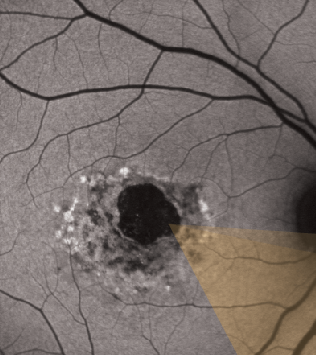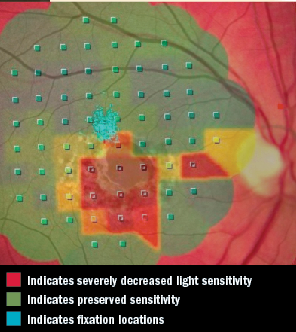Article
Stargardt’s disease: New strategies, new therapies
Several therapies are in the pipeline to treat Stargardt’s disease.
Take home
Several therapies are in the pipeline for the treatment of Stargardt’s disease. To show efficacy of such therapies, sensitive and clinically meaningful outcome measures are needed.
By Liz Meszaros; Reviewed by Hendrik P.N. Scholl, MD, MA
Baltimore-Pharmacologic, gene therapy, and stem cell therapy approaches to Stargardt’s disease are currently in clinical and pre-clinical development, said Hendrik P.N. Scholl, MD, MA.
“To show efficacy of such therapy, sensitive and clinically meaningful outcome measures are needed,” said Dr. Scholl, the Dr. Frieda Derdeyn Bambas professor of ophthalmology, Wilmer Eye Institute, Johns Hopkins University School of Medicine, Baltimore, and director of the Visual Neurophysiology Service at the institute.
The FDA recommended a prospective study on the natural history of Stargardt’s disease, he continued. To this end, The Natural History of the Progression of Atrophy Secondary to Stargardt’s Disease (ProgStar) Study was developed.
Further reading: Stargardt's disease treatment gains orphan designation
“The ProgStar Study will help to establish such outcomes measures and to build the infrastructure (such as data coordination and a central reading center), as well as establish technology (high-resolution imaging and visual function testing) and patient cohorts for the clinical trials,” he said.
Rationales for implementing this study are:
- To increase the chance of success of therapeutic trials.
- To understand better and clinically characterize the disease progression.
- To facilitate data collection on trends of progression for patient enrollment into treatment trials.
- To perform power calculations for drug studies.
- To determine and validate the best outcome measures to accelerate the evaluation of emerging treatments.


Figure 2. This fundus [Figure 1] autofluorescence (FAF) image of a 37-year-old male with Stargardt’s disease type 1 shows a central area with patches of reduced FAF signals (“black” areas), indicating a loss of retinal pigment epithelium (RPE). The area is surrounded by fleck-like areas of increased FAF signals (“white” flecks), indicating abnormally increased lipofuscin within the RPE. The inlay shows superposition of microperimetry results onto the FAF image where the retinal light sensitivity is color coded [Figure 2]. (Images courtesy of Hendrik P.N. Scholl, MD, MA)Figure 1
NEXT: Medical Therapy + Podcast
ProgStar will include nine clinical centers in North America and Europe, and is being led out of the Wilmer Eye Institute. The primary outcome measure will be lesion growth as determined by fundus autofluorescence imaging (with reduced illuminance), performed every 6 months, with the final measurement performed at 24 months. Secondary endpoints are retinal function testing with microperimetry and retinal imaging with spectral-domain optical coherence tomography.
“We will analyze the entire OCT cube per visit/per patient/per month, which will be 49 B scans per eye,” Dr. Scholl said. “We will perform segmentation analysis not only for total retinal thickness but also we will segment for RPE thickness, outer segments, inner segments, and the outer nuclear complex.
Listen to Hendrik P.N. Scholl, MD, MA, discuss the various therapies in clinical development for Stargardt’s disease during the annual Current Concepts in Ophthalmology meeting at the Wilmer Eye Institute/Johns Hopkins University.
“We will take advantage of all the algorithms that allow us to do semi-automated quantification of all of those layers (and) will correlate the findings with functional testing,” he explained, adding that the FDA would eventually like to see an outcome measure evaluated in a clinical trial that is correlated with visual function.
Medical therapy
Several compounds have shown promise as potential medical therapy of Stargardt’s disease, Dr. Scholl said.
“Toxic A2E accumulates in every retina, but at a much higher rate in Stargardt’s disease retinas,” he said. “A2E forms through non-enzymatic reactions between two vitamin A molecules. One way to modify the accumulation of A2E would be to slow the regeneration of visual pigment (the so-called visual cycle). Then, in theory at least, A2E would accumulate at a lower rate.
“This is currently being investigated,” he said.
In addition, deuterated vitamin A are may help slow the accumulation of A2E by blocking its formation downstream the visual cycle, Dr. Scholl explained. The safety effects of deuterated vitamin A are currently in a phase Ia trial.
Gene therapy
Gene therapy is also being developed and there is an active clinical trial in phase Ib. The program is being sponsored by Sanofi-Fovea. Pre-clinical data had been convincing to show that delivering the healthy gene to the photoreceptor had a significantly positive impact on A2E accumulation in a mouse model of the disease, Dr. Scholl said.
NEXT: Stem Cell Therapy
Stem cell therapy
Stem cell therapy is yet another option for the treatment of Stargardt’s disease that is also currently being studied, Dr. Scholl added.
From the Advanced Cell Technology trial there is a preliminary report on stem cell therapy in age-related macular degeneration and Stargardt’s disease. It is a phase I/II open-label, multicenter, non-randomized, prospective study to test the safety and tolerability of subretinal transplantation of hESC-derived retinal pigment epithelium cells in patients with Stargardt’s disease.
“This is a very preliminary dataset on only two patients that was widely criticized,” he said. “Still, it’s nice to see that at least in those two patients, after 4 months, there was no safety signal, such as tumor formation.”

References
1. Zarbin MA, Rosenfeld PJ. Pathway-based therapies for age-related macular degeneration: an integrated survey of emerging treatment alternatives. Retina. 2010;30:1350-1367.
2. Ma L, Kaufman Y, Zhang J, Washington I. C20-D3-vitamin A slows lipofuscin accumulation and electrophysiological retinal degeneration in a mouse model of Stargardt disease. J Biol Chem. 2011;286:7966-7974.
3. Maeda A, et al. Primary amines protect against retinal degeneration in mouse models of retinopathies. Nat Chem Biol. 2012;8:170–178.
4. Kong J, Kim SR, Binley K, Pata I, Doi K, Mannik J, Zernant-Rajang J, Kan O, Iqball S, Naylor S, Sparrow JR, Gouras P, Allikmets R. Correction of the disease phenotype in the mouse model of Stargardt disease by lentiviral gene therapy. Gene Ther. 2008;15:1311-1320.
5. Binley K, Widdowson P, Loader J, Kelleher M, Iqball S, Ferrige G, de Belin J, Carlucci M, Angell-Manning D, Hurst F, Ellis S, Miskin J, Fernandes A, Wong P, Allikmets R, Bergstrom C, Aaberg T, Yan J, Kong J, Gouras P, Prefontaine A, Vezina M, Bussieres M, Naylor S, Mitrophanous KA. Transduction of photoreceptors with equine infectious anemia virus lentiviral vectors: Safety and biodistribution of StarGen or Stargardt disease. Invest Ophthalmol Vis Sci. 2013;54:4061-4071.
5. Schwartz SD, Hubschman J-P, Heilwell G, et al. Embryonic stem cell trials for macular degeneration: a preliminary report. Lancet 2012 ;379;713-720.
Hendrik P.N. Scholl, MD, MA
P: 410/614-6908
F: 410/614-2186
Dr. Scholl has no financial interest in the subject matter. For more information, a central website for the study is accessible at www.progstar.org.
Newsletter
Don’t miss out—get Ophthalmology Times updates on the latest clinical advancements and expert interviews, straight to your inbox.




